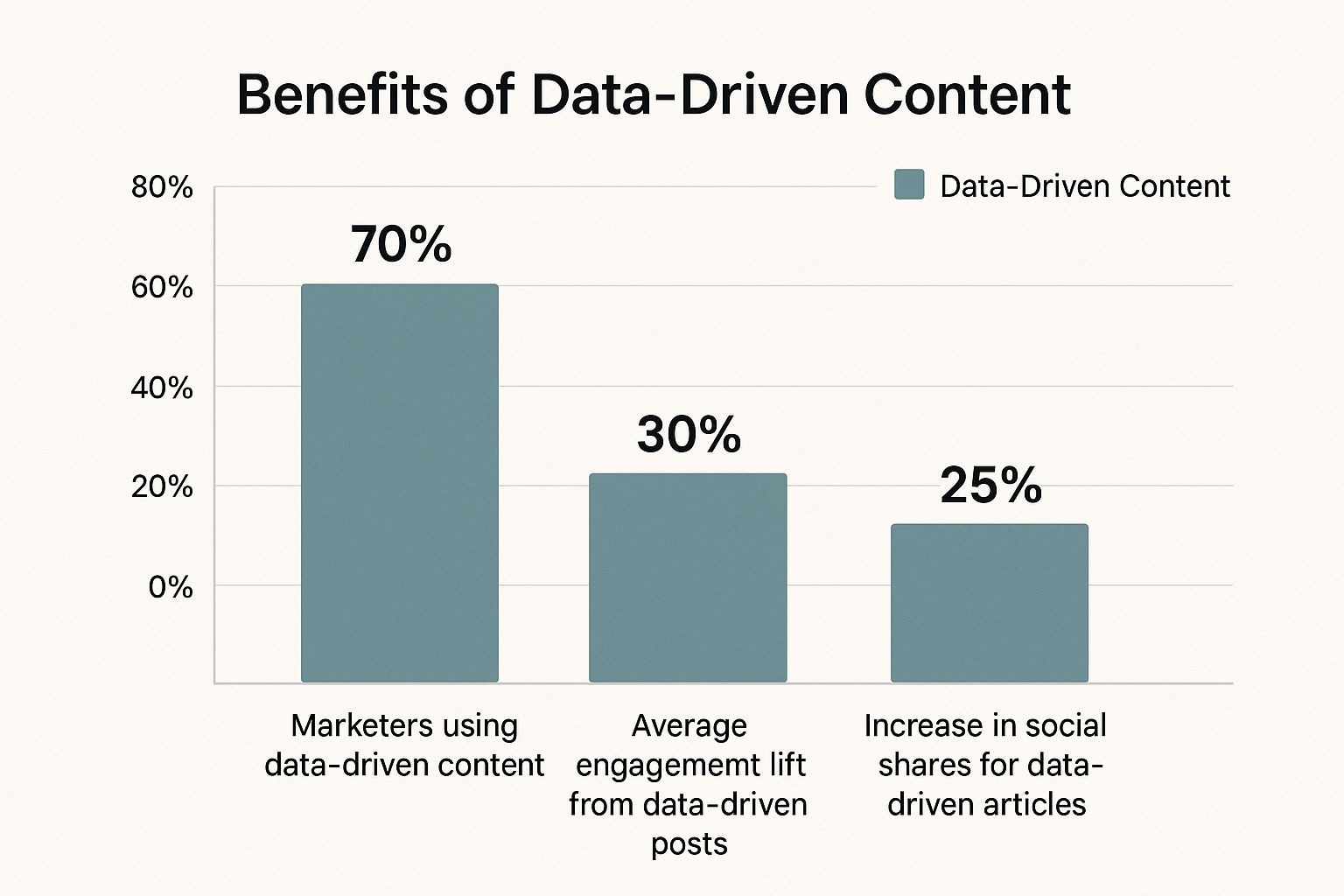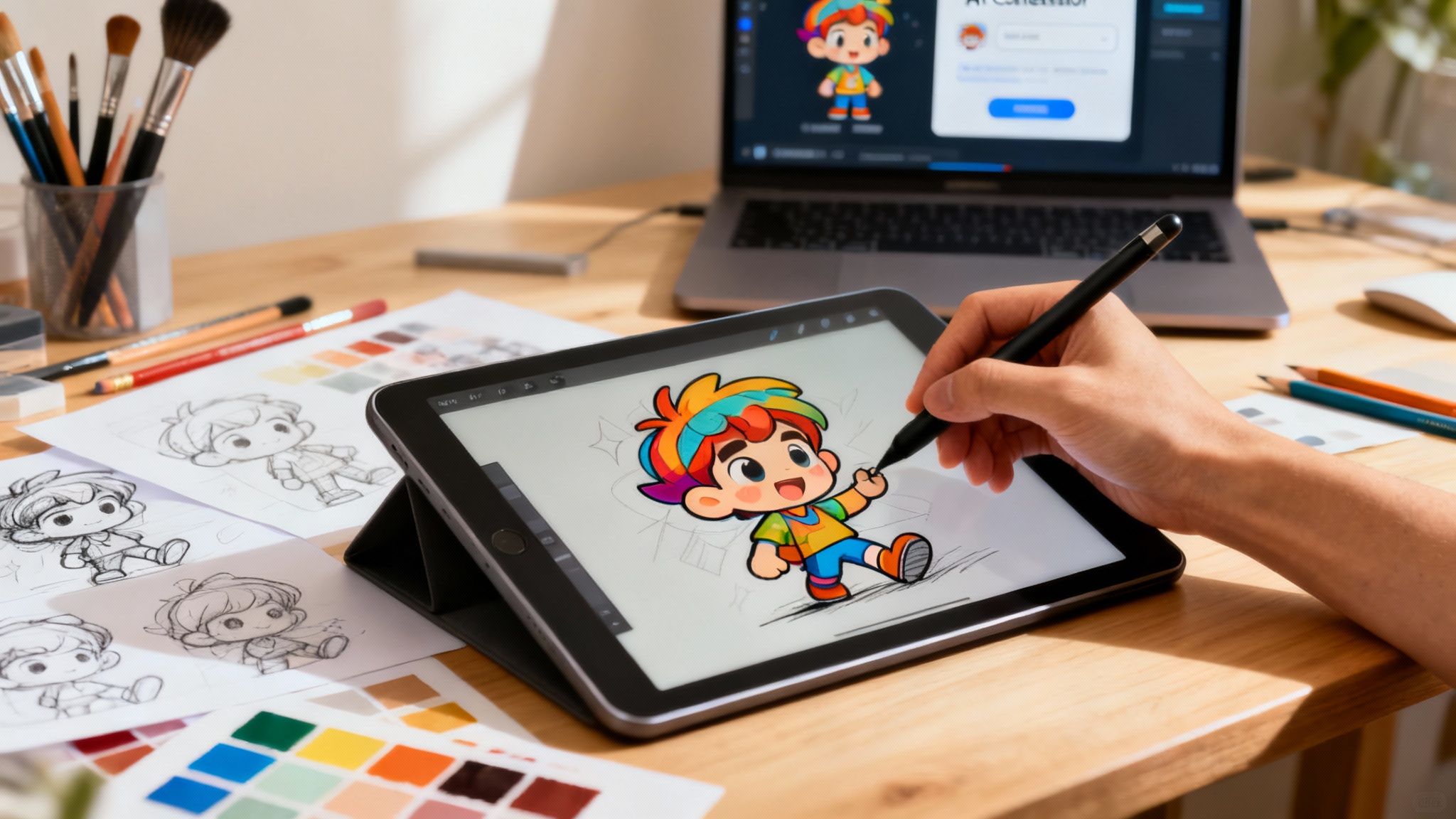
Struggling to fill your content calendar? You're not alone. For digital marketers, creators, and agencies, the pressure to consistently produce fresh, engaging material that cuts through the digital noise is a constant challenge. It's not just about posting frequently; it's about creating content that truly connects with your audience, builds a community, and drives results. When your go-to strategies feel stale, it's easy to fall into a creative slump, leading to repetitive posts and declining engagement. This article provides a toolkit of powerful ideas for content creation designed to break that cycle and reignite your strategy.
1. Behind-the-Scenes Content
Behind-the-scenes (BTS) content is a powerful way to build trust and humanize your brand. It pulls back the curtain, giving your audience an exclusive look into your process, culture, and the real people behind your work. This transparency transforms passive viewers into a connected community that feels like insiders, fostering loyalty and deeper engagement. It's one of the most authentic ideas for content creation because it replaces polished marketing with genuine moments. For a digital agency, this could be a short video of a brainstorming session for a new client campaign. For a software company, it could be a time-lapse of a coding session or a candid Q&A with the engineering team.

How to Implement Behind-the-Scenes Content
- Showcase the Process: Document how your product is made or a service is delivered. This could be a factory tour video or Instagram Stories showing product development sketches.
- Highlight Your Team: Introduce the people who make your company run. A "day in the life" post or a quick interview with a team member adds a personal touch.
- Embrace Raw Moments: Share challenges and how you overcame them. Authenticity builds a stronger connection than a feed of constant perfection.
- Create Recurring Series: Develop a consistent BTS series, like "Workshop Wednesdays" or "Team Spotlight Fridays," to keep your audience coming back for more.
2. User-Generated Content (UGC) Campaigns
User-Generated Content (UGC) campaigns turn your audience into your most authentic advocates. This strategy encourages your customers and followers to create and share content featuring your brand or product. By tapping into the creativity of real users, you build powerful social proof, increase brand visibility, and foster a vibrant community—all while easing your own content creation workload. It is one of the most effective ideas for content creation for building trust and organic reach. For instance, GoPro’s entire marketing model is built on featuring thrilling adventure videos submitted by its customers, transforming them into active brand participants.

How to Implement UGC Campaigns
- Create a Clear Call-to-Action: Launch your campaign with simple guidelines. Define the theme, specify a unique branded hashtag like Coca-Cola’s #ShareACoke, and clearly state what you want users to do.
- Offer Meaningful Incentives: Motivate participation by offering recognition, discounts, or a chance to be featured on your brand's official channels.
- Feature and Celebrate Submissions: Actively engage with participants by liking, commenting on, and sharing their posts. Feature the best submissions on your profiles to show appreciation.
- Establish Content Rights: Be transparent. Clearly state in your terms how you plan to use submitted content, ensuring you have the necessary permissions to repurpose it.
3. Educational Tutorial Series
An educational tutorial series is a strategic way to establish authority and provide consistent value. By breaking down complex topics into sequential, step-by-step guides, you address specific pain points and position your brand as a go-to resource. This approach is one of the most effective ideas for content creation because it builds a loyal following that returns for each new installment. For example, a digital marketing agency could create a video series on "Google Ads for Beginners," starting with account setup and progressing to advanced bidding strategies. This empowers your audience and demonstrates your expertise.
How to Implement an Educational Tutorial Series
- Structure Content Sequentially: Start with foundational concepts before moving to more advanced topics. Organize the series into a logical learning path.
- Use Clear Visuals: Incorporate screen recordings, infographics, or hands-on demonstrations to make instructions easy to follow.
- Break Down Complex Topics: Divide a broad subject into smaller, digestible episodes or articles. Each piece should solve a specific problem.
- Incorporate AI for Efficiency: Speed up your workflow by using the best AI tools for content creation to generate scripts, outlines, and supplementary materials.
- Create Centralized Hubs: Group your tutorials into a playlist on YouTube or a dedicated category on your blog to make the series easy to follow.
👉 Try MediaWorkbench.ai for free – generate AI content and schedule your posts in one place!
4. Interactive Live Streaming
Interactive live streaming is a dynamic form of real-time content where the audience actively participates through comments, questions, and polls. This format breaks down the barrier between creator and viewer, fostering immediate engagement and building a loyal community. It’s one of the most powerful ideas for content creation because it provides authentic, unfiltered communication. A digital agency can host a live Q&A on LinkedIn with their lead strategist to discuss marketing trends, while a software company can conduct a live product demo on YouTube, allowing potential customers to ask questions and see features in real-time.

How to Implement Interactive Live Streaming
- Prepare Key Points, Not a Script: Have a clear outline of topics but remain flexible to adapt to audience questions. This keeps the stream structured yet spontaneous.
- Promote Your Stream in Advance: Build anticipation by announcing your live event across all channels. Use countdown timers or schedule reminder posts. A complete creator's roadmap for going live on TikTok offers valuable platform-specific insights.
- Actively Encourage Participation: Directly ask your audience questions, run polls, and give shout-outs to viewers who comment.
- Repurpose Your Live Content: After the stream ends, save the recording. You can edit it into shorter clips for social media or write a blog post summarizing the key takeaways.
5. Trend Hijacking and Real-Time Marketing
Trend hijacking, or real-time marketing, is the art of capitalizing on current events, viral memes, and popular culture moments to boost your brand's visibility. This strategy involves creating timely, relevant content that connects a trending topic to your brand in an authentic way. When done right, it can lead to massive engagement and exposure, making it one of the most dynamic ideas for content creation available. The most famous example is Oreo's "You can still dunk in the dark" tweet during the 2013 Super Bowl blackout, a post that generated huge buzz in minutes by being clever, timely, and brand-aligned.
How to Implement Trend Hijacking
- Monitor Trends Actively: Use social media monitoring tools or even Twitter's trending topics to stay ahead of what's capturing public attention.
- Establish a Rapid-Response Workflow: Speed is critical. Create a streamlined approval process that allows your team to create and publish content within hours, not days.
- Ensure Brand Alignment: Not every trend is right for your brand. Before jumping in, ask if the topic aligns with your brand's voice and values. A mismatch can feel forced.
- Know When to Stay Silent: The most important part of trend hijacking is knowing when not to participate. Avoid sensitive or controversial topics where a marketing message would be inappropriate.
6. Storytelling Through Series Content
Series-based storytelling involves crafting a sequence of connected pieces that build upon each other to tell a larger narrative. Instead of one-off posts, this episodic format creates anticipation and builds a loyal audience that eagerly awaits each new installment. It is one of the most effective ideas for content creation for fostering long-term community. For instance, a podcast like Serial captivated listeners by unfolding a real-life investigative story week by week, making each episode a must-hear event. This strategy allows for a much deeper exploration of topics than a single piece of content ever could.

How to Implement Storytelling Through Series Content
- Plan the Narrative Arc: Before you begin, outline the entire series. Know your beginning, middle, and end to ensure a cohesive story.
- Create Accessible Entry Points: While the series is connected, ensure each episode can be understood on its own. This allows new audience members to jump in.
- Maintain Consistency: Use a consistent visual style, tone of voice, and narrative structure throughout the series to reinforce your brand identity.
- End with a Hook: Conclude each episode with a cliffhanger, a compelling question, or a preview of the next installment to create anticipation.
7. Data-Driven Content and Research
Data-driven content creation uses analytics, research, and statistical information to build authoritative articles, reports, and infographics. This approach moves beyond guesswork, grounding your strategy in real-world evidence. By transforming raw numbers into compelling narratives, you establish credibility and create resources that naturally attract links and shares. It's one of the most powerful ideas for content creation for building thought leadership. For example, HubSpot's annual "State of Marketing" reports are built on extensive survey data, making them an essential resource for marketers and generating sustained organic traffic.
How to Implement Data-Driven Content
- Survey Your Audience: Distribute surveys to your email list or social media followers to generate proprietary data that is unique to your brand.
- Analyze Internal Data: Use your own analytics to identify trends. Write about your most popular products or most-read blog topics to provide actionable insights. Learn more about how to leverage data with marketing automation best practices.
- Visualize the Story: Use charts, graphs, and infographics to make complex data easy to understand and share.
- Focus on Actionable Insights: Don't just share data; interpret it. Explain what the numbers mean and provide concrete takeaways for your audience.
8. Cross-Platform Content Adaptation
Cross-platform content adaptation is the strategic process of repurposing one core asset for different channels. Instead of creating unique content for every platform, you tailor a central piece to fit each channel's specific audience and format. This method boosts your content ROI and ensures a consistent message across your digital presence. It's a smart idea for content creation that values efficiency. For example, a long-form podcast episode can be repurposed into a detailed blog post, a series of quote graphics for Instagram, a thought-provoking Twitter thread, and short video clips for TikTok.
How to Implement Cross-Platform Content Adaptation
- Create a Core "Pillar" Asset: Start with a substantial piece of content like a webinar, in-depth blog post, or long-form video.
- Deconstruct for Micro-Content: Break down your pillar asset into smaller, digestible pieces, like key quotes, data points, or short video segments.
- Optimize for Each Platform: Tailor each piece to its intended platform. A B2B insight from a blog post becomes a professional text graphic for LinkedIn.
- Use Automation Tools: Streamline your multi-platform publishing workflow by exploring how social media automation software can help.
9. Community-Driven Q&A Content
Community-driven Q&A content turns your audience into collaborators by directly answering their questions. This strategy guarantees relevance and value, as the topics come straight from the people you want to reach. By sourcing ideas directly from your community, you build a loyal following that feels heard and understood. It’s one of the most effective ideas for content creation for fostering direct engagement. A digital marketing agency could host a weekly "Ask an Expert" session on Instagram Stories, answering user-submitted questions about SEO, or a software company could create a blog post compiling answers to common support questions.
How to Implement Community-Driven Q&A Content
- Create Submission Channels: Use Instagram's Q&A sticker, a dedicated form on your website, or a recurring LinkedIn post to collect questions.
- Categorize and Theme Your Content: Group similar questions to create themed content like "Marketing Myths Debunked" or "Founder FAQ Fridays."
- Credit Your Audience: When answering a question, give a shout-out to the person who asked it (with their permission) to encourage more submissions.
- Provide Comprehensive Answers: Go beyond simple replies. Offer detailed, actionable advice and share relevant resources to showcase your expertise.
10. Collaborative Content Creation
Collaborative content creation involves partnering with other creators, influencers, or brands to produce content together. This strategy is a powerful way to tap into new audiences, lend credibility to your brand, and introduce fresh perspectives. By joining forces, you combine your reach and expertise for a synergistic effect. It's one of the most effective ideas for content creation for exponential growth. For example, a marketing agency could co-host a webinar with a SaaS company whose tool complements their services, providing value to both audiences while cross-promoting.
How to Implement Collaborative Content Creation
- Choose Complementary Partners: Identify creators or brands whose audience and expertise align with yours but don't directly compete.
- Establish Clear Expectations: Before starting, create an agreement outlining responsibilities, deliverables, and promotion schedules.
- Create Mutually Beneficial Content: Plan a project that serves both your goals, such as a guest podcast episode, a joint video series, or an Instagram takeover.
- Develop a Cross-Promotion Strategy: Maximize reach by coordinating how and when each partner will share the content across their channels for an amplified impact.
Turn Your Ideas Into High-Performing Content
We've explored ten powerful ideas for content creation, from the authenticity of behind-the-scenes glimpses to the authority of data-driven reports. Each strategy offers a unique way to connect with your audience, but the real key to success is shifting from asking, "What should I post today?" to "What value can I provide my community?" Whether you are launching a live stream, hijacking a trend, or collaborating with a peer, an audience-centric mindset is the foundation of a content strategy that builds a loyal, engaged community. The most brilliant idea remains just a concept without execution, and the true challenge is building a sustainable workflow to bring that inspiration to life consistently.
Ready to turn these ideas for content creation into reality without the hassle? Media Workbench AI provides the tools you need to generate, schedule, and optimize your social media content in one unified platform. Stop juggling multiple apps and start building a more efficient workflow. Explore our features and see how AI can streamline your content creation today.

